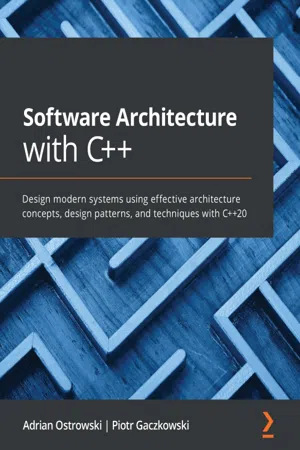
- 540 pages
- English
- ePUB (mobile friendly)
- Available on iOS & Android
Software Architecture with C++
About this book
Apply business requirements to IT infrastructure and deliver a high-quality product by understanding architectures such as microservices, DevOps, and cloud-native using modern C++ standards and featuresKey Features• Design scalable large-scale applications with the C++ programming language• Architect software solutions in a cloud-based environment with continuous integration and continuous delivery (CI/CD)• Achieve architectural goals by leveraging design patterns, language features, and useful toolsBook DescriptionSoftware architecture refers to the high-level design of complex applications. It is evolving just like the languages we use, but there are architectural concepts and patterns that you can learn to write high-performance apps in a high-level language without sacrificing readability and maintainability.If you're working with modern C++, this practical guide will help you put your knowledge to work and design distributed, large-scale apps. You'll start by getting up to speed with architectural concepts, including established patterns and rising trends, then move on to understanding what software architecture actually is and start exploring its components. Next, you'll discover the design concepts involved in application architecture and the patterns in software development, before going on to learn how to build, package, integrate, and deploy your components. In the concluding chapters, you'll explore different architectural qualities, such as maintainability, reusability, testability, performance, scalability, and security. Finally, you will get an overview of distributed systems, such as service-oriented architecture, microservices, and cloud-native, and understand how to apply them in application development.By the end of this book, you'll be able to build distributed services using modern C++ and associated tools to deliver solutions as per your clients' requirements.What you will learn• Understand how to apply the principles of software architecture• Apply design patterns and best practices to meet your architectural goals• Write elegant, safe, and performant code using the latest C++ features• Build applications that are easy to maintain and deploy• Explore the different architectural approaches and learn to apply them as per your requirement• Simplify development and operations using application containers• Discover various techniques to solve common problems in software design and developmentWho this book is forThis software architecture C++ programming book is for experienced C++ developers looking to become software architects or develop enterprise-grade applications.
Frequently asked questions
- Essential is ideal for learners and professionals who enjoy exploring a wide range of subjects. Access the Essential Library with 800,000+ trusted titles and best-sellers across business, personal growth, and the humanities. Includes unlimited reading time and Standard Read Aloud voice.
- Complete: Perfect for advanced learners and researchers needing full, unrestricted access. Unlock 1.4M+ books across hundreds of subjects, including academic and specialized titles. The Complete Plan also includes advanced features like Premium Read Aloud and Research Assistant.
Please note we cannot support devices running on iOS 13 and Android 7 or earlier. Learn more about using the app.
Information
- Chapter 1, Importance of Software Architecture and Principles of Great Design
- Chapter 2, Architectural Styles
- Chapter 3, Functional and Nonfunctional Requirements
- Understanding software architecture
- Learning the importance of proper architecture
- Exploring the fundamentals of good architecture
- Developing architecture using Agile principles
- The philosophy of C++
- Following the SOLID and DRY principles
- Domain-driven design
- Coupling and cohesion
Technical requirements
- A Git client for checking out the repositories given shortly.
- A C++20-compliant compiler to compile all the snippets. Most of them are written in C++11/14/17, but concept support is required to experiment with the few that touch the subject.
- GitHub link for code snippets: https://github.com/PacktPublishing/Software-Architecture-with-Cpp/tree/master/Chapter01.
- GitHub link for GSL: https://github.com/Microsoft/GSL
Understanding software architecture
Different ways to look at architecture
- Enterprise architecture deals with the whole company or even a group of companies. It takes a holistic approach and is concerned about the strategy of whole enterprises. When thinking about enterprise architecture, you should be looking at how all the systems in a company behave and cooperate with each other. It's concerned about the alignment between business and IT.
- Solution architecture is less abstract than its enterprise counterpart. It stands somewhere in the middle between enterprise and software architecture. Usually, solution architecture is concerned with one specific system and the way it interacts with its surroundings. A solution architect needs to come up with a way to fulfill a specific business need, usually by designing a whole software system or modifying existing ones.
- Software architecture is even more concrete than solution architecture. It concentrates on a specific project, the technologies it uses, and how it interacts with other projects. A software architect is interested in the internals of the project's components.
- Infrastructure architecture is, as the name suggests, concerned about the infrastructure that the software will use. It defines the deployment environment and strategy, how the application will scale, failover handling, site reliability, and other infrastructure-oriented aspects.
Learning the importance of proper architecture
Software decay
Accidental architecture
Exploring the fundamentals of good architecture
Architecture context
Stakeholders
Business and technical environments
Table of contents
- Title Page
- Copyrights
- Dedication
- Contributors
- Preface
- Section 1: Concepts and Components of Software Architecture
- Importance of Software Architecture and Principles of Great Design
- Architectural Styles
- Functional and Nonfunctional Requirements
- Section 2: The Design and Development of C++ Software
- Architectural and System Design
- Leveraging C++ Language Features
- Design Patterns and C++
- Building and Packaging
- Section 3: Architectural Quality Attributes
- Writing Testable Code
- Continuous Integration and Continuous Deployment
- Security in Code and Deployment
- Performance
- Section 4: Cloud-Native Design Principles
- Service-Oriented Architecture
- Designing Microservices
- Containers
- Cloud-Native Design
- Appendix A
- Assessments
- About Packt
- Other Books You May Enjoy